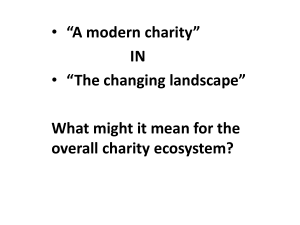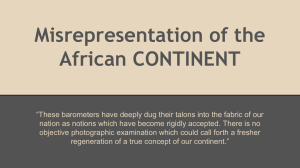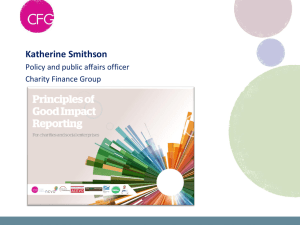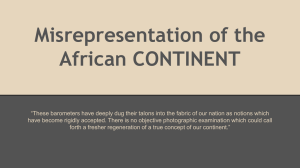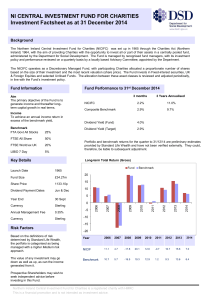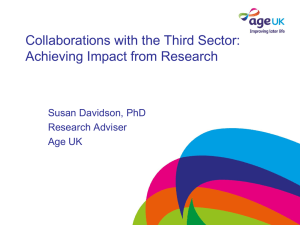Business Critical Data in Scottish Charities: Findings from a Survey
advertisement
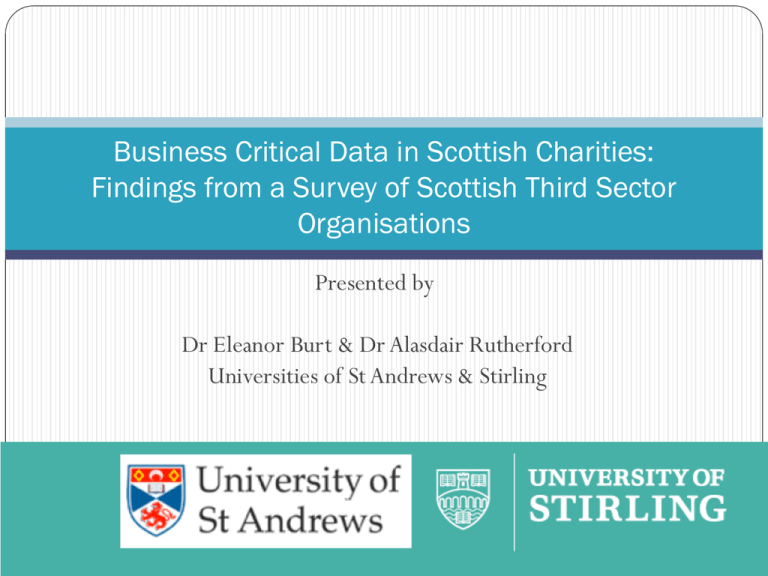
Business Critical Data in Scottish Charities: Findings from a Survey of Scottish Third Sector Organisations Presented by Dr Eleanor Burt & Dr Alasdair Rutherford Universities of St Andrews & Stirling What was the research about? The research gathered information about: the extent to which Scottish charities are using ‘business critical’ data key sources of ‘business critical’ data used by Scottish charities what aids utilisation of this data in Scottish charities what impedes utilisation of this data in Scottish charities Why did we do the research? Business critical data is a critically important resource and its importance is still growing Data has never been so widely available as it is now The availability of this data is affording important opportunities and important challenges Little is known about how charities are engaging with this data & the opportunities and challenges it is generating for them How did we do the research? The research took the form of a postal questionnaire survey Questionnaires were mailed to 704 Scottish charities Responses were received from 161 Scottish charities (23%). The survey was completed between November 2013 and January 2014. Who participated in the research? The participating charities: had annual incomes of £1 million or over mainly originated in the ‘Internet era’ (1976 onwards) around 17% were established in the current ‘computing-on-the-go’ period (2000 – onwards). operated mainly in health and social welfare, housing, and culture/leisure Discussion 1. What does ‘business critical’ data bring to your organisation? 2. Where is your organisation data rich, and why? 3. Where is it data poor, and why? Headline Findings A small number of the charities that we looked at can be described as Struggling with data, while the majority are Managing or Just about Managing and a few are Pushing the Boundaries. Charities that are Pushing the Boundaries led the way in reporting seven of the ten data sources that we looked at, including three of the newer types (social networking forums, smart cards, and data analytics) as being extremely useful. 75% of the Pushing the Boundaries group reported that leadership was extremely important in driving data utilisation, by contrast with 42.5% of the Managing group, and fewer than 40% in each of the Just about Managing and Struggling groups. Are charities engaging effectively with data? We asked respondents to indicate which of four archetypes - Pushing the Boundaries, Managing, Just about Managing, and Struggling - best reflected their charity’s use of data. 5% regarded their charities as Pushing the Boundaries, almost 25% as Managing , nearly 51% as Just about Managing, and 11% described themselves as Struggling. Almost 65% of participants stated that their charity has a formal data management strategy. 60% Struggling Just about managing 50% Managing Pushing the boundaries 40% 30% 20% 10% 0% £1M to £2M £2M to £5M £5M to £10M £10M Plus What data sources are most useful? Almost 74% of participants stated that their charity’s user/member database is an extremely useful source of data. Almost 47% of participants stated that data from their charity’s website is extremely useful. 36% of participants indicated that their charity’s fundraising database is an extremely useful source of data. 32% of participants stated that their charity’s volunteering database is an extremely useful source of data. Almost 30% of participants stated that their charity’s social networking forums are an extremely useful source of data. Fewer that 7% of participants stated that smart cards are an extremely useful source of data. [We anticipated that only a small number of charities would be using smart cards.] Fewer than 19% of participants stated that trends data is extremely useful. Discussion 4. How well is business critical data communicated and shared in your organisation? 5. How well is this data communicated between your organisation and other organisations with which it works? 6. How well does your organisation ‘pull in’ this data from outside sources, such as social media? Data Communication How regularly do charities provide data to other organisations? How regularly do charities receive data from other organisations? 9% of charities provide data on a daily basis to organisations on whose behalf they deliver a service. 7% of charities provide data on a daily basis to organisations with which they collaborate. Almost 12% of charities receive data on a daily basis from organisations on whose behalf they deliver a service. 13% of charities receive data on a daily basis from organisations with which they collaborate. What do charities find easy/difficult? 41% of charities find knowing where to look for data easy. Almost 37% of charities find knowing the questions to ask of data easy. Almost 38% just about manage when it comes to accessing data, while 33% find this easy. 3% of charities find integrating their own internal data extremely difficult and almost 19% find this difficult. 3% of charities find analysing and understanding data extremely difficult and almost 15% report that this is difficult. 100% Struggling Just about managing Managing Pushing the boundaries 90% 80% 70% 60% 50% 40% 30% 20% 10% 0% Costs Time Integrating IT within charity Integrating IT with Agreeeing shared partner information organisations standards externally Barriers The top 5 barriers to engagement with data were: Costs, Time, Integrating IT (both internally and externally), Agreeing shared information standards. Costs and Time were most significant for Struggling charities, whereas external factors (It and information standards) were most significant for the Pushing the Boundaries charities. What are the main drivers of data usage? 65% of participants said that reporting and accountability requirements are extremely important in driving data utilisation. 58% said that appreciating how data can inform strategic and operational decisions is extremely important. Almost 52% stated that improving resource utilisation was an extremely important driver. Just 40% of participants perceived leadership to be extremely important in driving data utilisation, while almost 50% said that this was important. Discussion 7. What would allow your organisation to make better use of business critical data? 8. What major issues does this data raise for your organisation?
